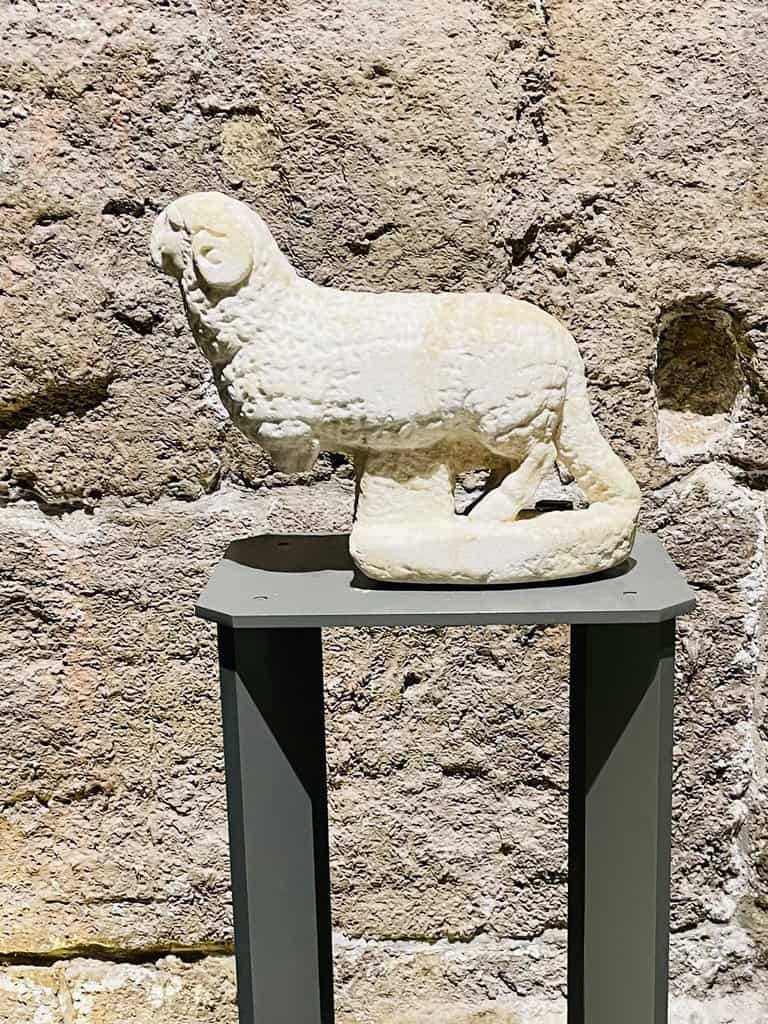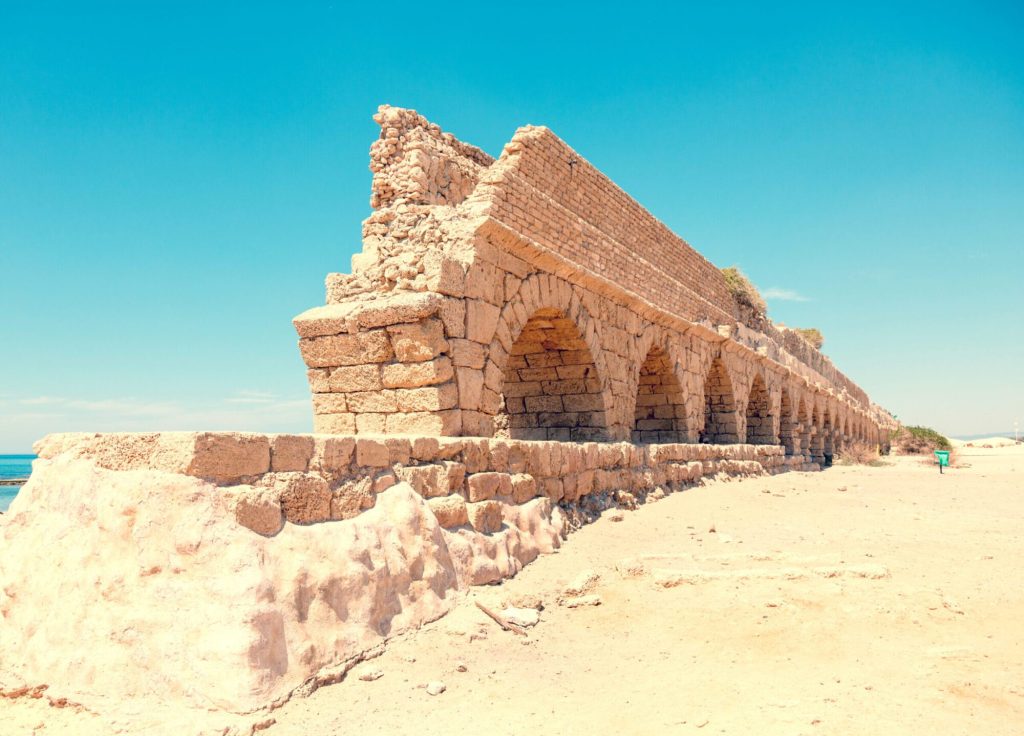The Cultic Area in Caesarea has been a vibrant area in the port city of Caesarea Maritima. Its importance and architectural richness made it one of the most important areas in the Roman and Byzantine city of Caesarea. In addition the recent excavations revealed many archeological remains from the time of Herod to the Crusader period.
The Cultic Area in Caesarea
At the center of recent excavation and conservation work of Caesarea National Park is the cultic precinct from about 2,030 years ago. In fact, it was the sacred compound that Herod built as a tribute to his patron Augustus, Roman emperor, and in honor of the goddess Rome. Moreover, the building of the Temple of Augustus and Rome, which overlooked the sea, was mentioned by Josephus in his book ‘Jewish Wars’.

According to Josephus, Herod built the temple at the top of the hill, which was unusual in size and appearance. In addition, inside the temple stood a huge statue of the emperor in the form of the Olympic Zeus, and another statue of the goddess Rome, in the form of Hera. These statues were not yet found in the excavation and may have been taken from the site earlier.

Recent excavations have uncovered an impressive system of vaults on the western façade of the ritual platform. This façade included two halls, the western side of which was open towards the harbor, and each of which was divided into four vaults. Between the two halls, a system of three smaller vaults was erected, which carried on its back a monumental staircase on which the following ascended from the harbor towards the sacred compound.

A Rare Find From Recent Excavations
An important and rare discovery was recently uncovered in front of the temple – a foundation of a large stone altar that stands inside a temple open to the sky, similar to the “Peace Altar” (the “Ara Pacis”) of Augustus in Rome. This altar was used for sacrificial offerings in honor of Emperor Augustus. Next to the altar, the foundations of other altars, small in size, were exposed. According to the diggers, dozens of deep pits discovered around the main altar were intended to hold torches or flags (symbols of the Roman Legion that the soldiers carried on poles).
The Cultic Area in Caesarea in the Byzantine Era
At the end of the fifth century, there was a fundamental change in the sacred compound in the Byzantine period. On top of the foundations of the Temple of Augustus and the Goddess of Rome, an octagonal church was erected. The altar built by Herod was dismantled, and a new entrance and staircase were built on the site, connecting the pier to the church. The Byzantine church was lavishly decorated and revetted in marble.
A Marble Ram Was Found In Recent Excavations
Recently, a marble ram was found during the archaeological excavations conducted in the cultic area in Caesarea. The marble ram was unearthed near a Byzantine-era church (6th – 7th centuries CE) in Caesarea in December 2015.
In ancient Christianity, Jesus was not portrayed as a person. Instead, symbols were used, one of which was the ram. It may or may not be a coincidence. The statue might have been part of the decoration of a Byzantine church at Caesarea.

“In Christian art, the ram is often depicted carried on the shoulders of the ‘Good Shepherd’ (that is, Jesus, who is portrayed as the shepherd tending his flock), and sometimes the ram is situated to the left or right of Jesus,” the scientists said.
In that context, it’s important to stress that in Christianity, the ram, like the lamb, represents the faithful, or Jesus himself, whose anguish and death was meant according to Christian belief to atone for original sin (the origin of the image is in John 29:1)
But it could also be dated to earlier times, maybe from the Roman period, and then the ram was incorporated into secondary use in the church structure. The ram appeared alongside the Greek gods Hermes and Mercury in Roman art, representing the god Amun in Egyptian mythology. So it’s hard to know precisely.
The Cultic Area in Caesarea in the Muslim Period
Caesarea was lost for good by the Byzantines to the Muslim conquest in 640. Archaeological excavations discovered a destruction layer connected to the Muslim conquest of the city. Some newer research posits that there was no destruction caused by the Persians in 614 and Muslim Arabs in 640, but rather a gradual economic decline accompanied by the Christian aristocracy fleeing the city.
The city likely remained inhabited under Arab rule, during the 7th and 8th centuries, albeit with a much-reduced population. Archaeological evidence shows a clear destruction layer identified with the conquest of 640, followed by some evidence of renewed settlement in the early Umayyad period.

By the 11th century, the town had once again been developed into a fortified city. Writing in 1047, Nasir-i-Khusraw describes it as “a fine city, with running waters, and palm gardens, and orange and citron trees. Its walls are strong, and it has an iron gate. There are fountains that gush out within the city”. This agrees with William of Tyre’s description of the Crusaders’ siege in 1101, mentioning catapults and siege engines used against the city fortifications.

Where the Byzantine church use to be, Nasir-i-Khusraw noted a “beautiful Friday Mosque” in Caesarea in year 1047, “so situated that in its court you may sit and enjoy the view of all that is passing on the sea.” This was converted into the church of St. Peter in Crusader times. A wall which may belong to this building has been identified in modern times
The Cultic Area in Caesarea: Conclusions
As you can see, there is an interesting phenomenon in human civilization. You can see this manifesting in Caesarea, but Jerusalem as a city is a good example. You can find this phenomenon all over the world. I’m referring to the archaeological principle called ‘Continuity of Cult.’ What does it mean? So, continuity of cult means simply that a specific location became sacred by a particular culture. The rest of the following civilizations would keep that location holy but would create their traditions.
So as you saw in the beginning, Herod the Great venerated this spot by building a temple for Rome and Augustus. Then, the Byzantines built an octagonal church there. Then, the Muslims took over and built a mosque there. And last, the Crusaders created a massive cathedral there Honoring St. Peter.

